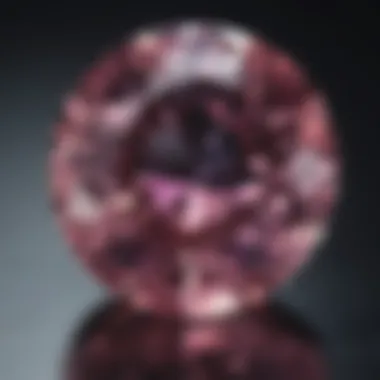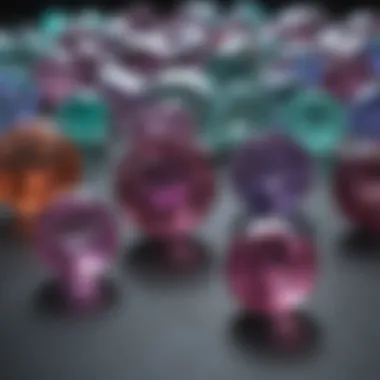Unlocking the Mysteries of Identifying Alexandrite Gemstones


Overview of Alexandrite Stone
The journey to identifying alexandrite stones begins with a profound understanding of gemstones and minerals. Alexandrite, a rare and prized gemstone revered for its color-changing properties, holds a significant place in the world of gemology. Its unique ability to shift colors under varying light sources sets it apart from other gemstones and makes it a coveted addition to any collection.
Gemstone Formation and Properties
Delving into the formation and properties of alexandrite unveils a fascinating process. Created through a combination of aluminum, beryllium, and trace elements such as chromium, this gemstone undergoes a transformational journey deep within the Earth's crust. Its distinctive properties, including its hardness, luster, and color-changing nature, make alexandrite a gemstone of unparalleled beauty and rarity.
Types of Gemstones
In the realm of gemstones, alexandrite stands out as a precious gem with unmatched allure. Distinguishing between precious and semi-precious gemstones, alexandrite firmly secures its place among the elite. Its uniqueness sets it apart from common gem varieties, positioning it as an exotic and rare find for gem enthusiasts and collectors alike.
Identifying and Evaluating Alexandrite Stones
Unraveling the secrets to identifying authentic alexandrite stones requires a keen eye and a wealth of knowledge. Various factors come into play when assessing the value of alexandrite, including its color, clarity, and cut. Techniques such as spectroscopy and microscopic analysis play a crucial role in distinguishing genuine alexandrite from synthetic or imitated stones, ensuring that enthusiasts can confidently evaluate the quality and authenticity of their prized gems.
Caring for Alexandrite Stones
To preserve the beauty and allure of alexandrite stones, proper care and maintenance are essential. Cleaning and storing these gems correctly safeguard them against damage and deterioration, allowing their color-changing properties to shine brightly for years to come. By following expert preservation tips tailored to specific gem types, enthusiasts can ensure that their alexandrite stones retain their splendor and value over time.
Introduction
Welcome to this comprehensive guide on how to identify one of the most fascinating gemstones - Alexandrite. This stone, known for its unique color-changing properties, has captivated gemstone enthusiasts, collectors, jewelry designers, and geology enthusiasts alike. Understanding the nuances of Alexandrite is essential in the world of gemology, where knowledge and expertise hold significant value. Through this article, we will delve deep into the origin, properties, characteristics, identification methods, and differentiation techniques of Alexandrite.
The enigmatic allure of Alexandrite lies in its ability to exhibit different colors based on the light source, a phenomenon known as pleochroism. This remarkable feature sets Alexandrite apart from other gemstones, making it a coveted addition to any gem collection. By exploring the intricacies of Alexandrite, readers can enhance their appreciation for the natural wonders of the earth and gain valuable insights into gemstone authenticity.
To embark on this journey of discovery and mastery, we will unravel the mysteries surrounding Alexandrite, equip you with the knowledge to discern genuine stones from their synthetic counterparts, and provide you with the tools to confidently identify and appreciate the beauty of this remarkable gem. Let us unlock the secrets of Alexandrite together, unraveling its brilliance and significance in the realm of precious gemstones.


Understanding Alexandrite
In the realm of gemstones, understanding alexandrite holds a paramount position due to its rare and valuable nature. Delving into the origins and formation of this exquisite gemstone provides gemstone enthusiasts, collectors, jewelry designers, and geology enthusiasts with a profound insight into its unique characteristics. By comprehending the intricacies of alexandrite, individuals elevate their gemstone expertise, enabling them to distinguish between genuine stones and synthetic alternatives effectively. This section serves as a cornerstone for readers, laying the foundation for a comprehensive understanding of alexandrite.
Origin and Formation
Deposits Locations
Exploring the deposits locations of alexandrite unveils crucial insights into its formation and availability. The specific geographical regions where alexandrite is found play a significant role in determining its quality and rarity. For instance, deposits in Russia and Brazil are renowned for yielding high-quality alexandrite with extraordinary color-change properties. The unique mineral structures in these locations contribute to the distinctive color variations observed in alexandrite, making them highly desirable for gemstone connoisseurs. Despite the advantages of sourcing alexandrite from these locations, challenges such as limited supply and extraction difficulties may pose drawbacks for prospective buyers.
Crystal Structure
The crystal structure of alexandrite is a key determinant of its physical properties and optical characteristics. Understanding the crystal lattice arrangement can provide valuable information regarding the gemstone's durability, clarity, and color-changing abilities. Alexandrite's chrysoberyl composition imparts it with a robust structure, ensuring longevity and resistance to external factors. The octahedral crystal habit of alexandrite contributes to its pleochroic nature, enabling the gem to exhibit varying colors under different lighting conditions. This distinctive crystal structure sets alexandrite apart from other gemstones, enhancing its allure and value in the gemstone market.
Color-Change Phenomenon
The mesmerizing color-change phenomenon displayed by alexandrite is one of its most captivating features. Under distinct lighting sources, such as natural sunlight and incandescent light, alexandrite reveals a remarkable transformation in hue, shifting between shades of green, blue, and red. This optical phenomenon, known as pleochroism, showcases the gemstone's ability to adapt to its environment, creating a mesmerizing visual display. The color-change property of alexandrite adds to its mystique and allure, making it a prized possession among gemstone enthusiasts and collectors.
Properties and Characteristics
Color Variations
The diverse color variations exhibited by alexandrite contribute to its allure and rarity in the gemstone market. Ranging from vibrant greens to rich purples, the changing colors of alexandrite mesmerize observers, reflecting its chameleon-like qualities. The gem's ability to shift colors under different lighting conditions enhances its visual appeal, making it a coveted choice for jewelry designs and collectible pieces. The intricacies of color variations in alexandrite underscore its uniqueness and desirability among discerning gemstone connoisseurs.
Clarity and Transparency
The clarity and transparency of alexandrite play a crucial role in determining its quality and value as a gemstone. High-quality alexandrite exhibits exceptional clarity, free from inclusions or imperfections that may hinder its optical properties. The gemstone's transparency allows light to pass through effortlessly, enhancing its color display and brilliance. Evaluating the clarity and transparency of alexandrite is essential for discerning genuine stones from imitations, ensuring authenticity and value for consumers and collectors alike.
Refractive Index


The refractive index of alexandrite governs its optical properties and light behavior, influencing the gemstone's brilliance and sparkle. With a refractive index that falls within a specific range, alexandrite displays striking visual effects, such as color dispersion and reflection. Gemologists use the refractive index as a diagnostic tool to authenticate alexandrite and differentiate it from synthetic or imitation gemstones. Understanding the significance of the refractive index in alexandrite is crucial for evaluating its authenticity and discerning its color-changing properties with precision.
Identifying Genuine Alexandrite
Identifying Genuine Alexandrite is a critical part of this comprehensive guide on recognizing alexandrite stones. Understanding the true nature of these rare gemstones is essential for enthusiasts and collectors to ensure they are investing in authentic pieces. Genuine alexandrite possesses distinct characteristics and properties that set it apart from synthetic or imitation stones. By learning how to recognize these features, readers can build their expertise in gemstone evaluation and make informed decisions when acquiring alexandrite pieces.
Visual Inspection
Color Change in Different Light Sources
Color change in different light sources plays a pivotal role in identifying genuine alexandrite. This unique phenomenon, known as pleochroism, causes the stone to exhibit varying colors under different lighting conditions. Genuine alexandrite showcases a remarkable color shift from greenish-blue under daylight to purplish-red under incandescent light. This distinct color transformation is a hallmark feature of genuine alexandrite and serves as a definitive indicator of its authenticity. Understanding and observing this color change phenomenon are crucial steps in the identification process.
Inclusion Patterns
Analyzing inclusion patterns is another integral aspect of visually inspecting alexandrite stones. Natural alexandrite often contains characteristic inclusions such as needle-like rutile, fingerprint-like growth patterns, or liquid filled cavities. These inclusions are valuable clues that help gemologists differentiate between natural and synthetic alexandrite. Studying the type, quantity, and distribution of inclusions within a stone provides valuable insights into its authenticity and origin. By examining these unique features, enthusiasts can enhance their ability to discern genuine alexandrite from imitations.
Use of Testing Tools
Laser Pointer Test
The laser pointer test is a valuable tool in the arsenal of gemstone identification. This test involves directing a laser pointer at the alexandrite to observe how it interacts with light. Genuine alexandrite exhibits unique absorption properties that can be detected using this method. The stone's reaction to the laser pointer's light can help confirm its authenticity based on the characteristic color change and intensity of fluorescence. Gemologists rely on this test to validate the identity of alexandrite and distinguish it from synthetic or simulated alternatives.
Chelsea Filter Test
Another essential testing tool for alexandrite is the Chelsea Filter. This specialized filter emits specific wavelengths of light that reveal certain gemstone characteristics. When viewed through a Chelsea Filter, genuine alexandrite displays a distinct color change reaction, confirming its authenticity. This test aids in verifying the presence of chromium in the stone, which is responsible for its color-changing properties. By employing the Chelsea Filter test, experts can conduct a thorough examination of alexandrite specimens and confirm their natural origin.
Consulting Experts


Consulting experts in the field of gemology and alexandrite evaluation can provide invaluable insights and guidance. Experienced gemologists possess in-depth knowledge of gemstone identification techniques and have access to advanced testing equipment. Seeking expert opinions and analysis can offer clarity and verification regarding the authenticity of alexandrite stones. Collaborating with professionals in the industry enhances the credibility of gemstone assessments and ensures accurate identification results. By consulting experts, enthusiasts can refine their skills in distinguishing genuine alexandrite from synthetic or imitation alternatives.
Distinguishing from Synthetic and Imitation Stones
In the realm of identifying alexandrite stones, the section focusing on distinguishing synthetic and imitation stones holds paramount importance. By discerning genuine gemstones from counterfeits, enthusiasts and collectors safeguard their investments and uphold the integrity of their collections. A meticulous examination of lab-created stones and simulated imitations ensures that gemstone aficionados acquire authentic alexandrite, thereby enhancing their expertise and cultivating a discerning eye for quality. This section serves as a beacon of knowledge, illuminating the subtle yet crucial disparities between authentic alexandrite and its synthetic or simulated counterparts.
Identifying Lab-Created Stones
Fluorescence Under UV Light
The fluorescence under UV light emerges as a pivotal factor in the identification of lab-created alexandrite stones. This distinctive characteristic manifests as a glow or emission when exposed to ultraviolet light, offering gemologists a reliable method to differentiate between natural and synthetic gems. The fluorescence pattern under UV light serves as a prominent indicator of the stone's origin and authenticity, enabling enthusiasts to make informed decisions regarding their gem acquisitions. While fluorescence under UV light contributes significantly to the identification process, its absence or irregularity may raise suspicions regarding the gem's natural status.
Growth Patterns
Delving into growth patterns unveils another key aspect in discerning genuine alexandrite stones from lab-created replicas. These growth patterns, characterized by unique formations and structures within the gem, provide valuable insights into the stone's manufacturing process. By scrutinizing growth patterns under magnification, experts can unravel the intricate history of the gem's development, distinguishing natural alexandrite from synthetic replicas. Understanding and interpreting growth patterns play a vital role in differentiating authentic alexandrite gems from their synthetic counterparts, empowering gem enthusiasts to make informed choices and amass genuine treasures for their collections.
Differentiating from Simulated Stones
Glass Imitations
The examination of glass imitations serves as a pivotal step in the identification process of alexandrite gemstones. Glass imitations mimic the visual allure of authentic alexandrite, posing a challenge for even seasoned collectors. By scrutinizing the key characteristics of glass imitations, such as their refractive index and color saturation, gem enthusiasts can unveil subtle discrepancies that betray their synthetic nature. Distinguishing glass imitations from genuine alexandrite requires keen observation and a discerning eye for detail, ensuring that collectors acquire only authentic gemstones to enrich their collections.
Synthetic Spinel
Synthetic spinel emerges as another prominent contender in the realm of simulated alexandrite stones. With its striking resemblance to natural alexandrite, synthetic spinel presents a formidable challenge to gemstone connoisseurs seeking genuine specimens. By exploring the key characteristic of synthetic spinel, including its chemical composition and optical properties, collectors can uncover telltale signs that set it apart from authentic alexandrite. The thorough examination and differentiation of synthetic spinel from genuine alexandrite gems play a crucial role in fortifying collectors' knowledge and enabling them to make informed decisions in their pursuit of precious gemstones.
Conclusion
The conclusion of this article holds paramount significance in equipping gemstone enthusiasts, collectors, jewelry designers, and geology enthusiasts with the essential knowledge required to confidently identify alexandrite stones. By delving deep into the multifaceted aspects of recognizing genuine alexandrite gems and distinguishing them from synthetics and imitations, readers are empowered to enhance their expertise in the realm of gemstone evaluation and procurement.
The meticulous examination of origin, formation, color-change phenomenon, properties, and characteristics of alexandrite imparts a profound understanding of the gem's rarity and allure. Through visual inspection techniques and the use of specialized testing tools such as the laser pointer and Chelsea filter tests, readers are equipped with practical methodologies to discern authentic alexandrite stones through distinct color variations and inclusion patterns.
Furthermore, the guidance on identifying lab-created stones through fluorescence under UV light and growth patterns, as well as the differentiation from simulated stones like glass imitations and synthetic spinel, serves as a comprehensive resource for ensuring the authenticity of alexandrite acquisitions.
In essence, the conclusion of this comprehensive guide encapsulates the expertise and precision required to navigate the intricate world of alexandrite gemstones with confidence and proficiency. By providing detailed insights and actionable steps for identification, this article enriches the gemstone knowledge of readers and fortifies their ability to make informed decisions in acquiring authentic alexandrite gems.







